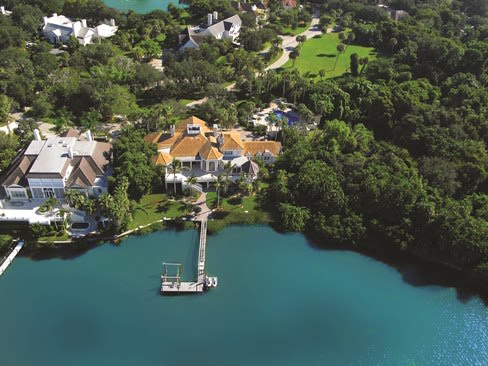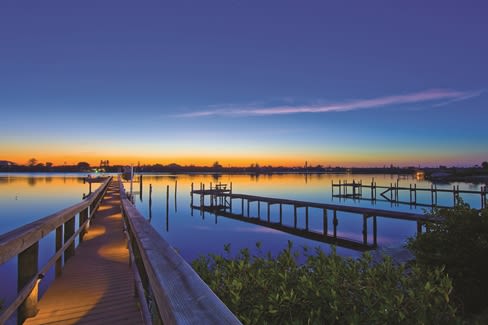Where's the Money?
by Rich Rescigno
Photography by Everett Dennison
Wealth is moving into Sarasota faster than almost any other place in the country. Here's who's coming--and why.
Wealth voyeurism is a wonderful thing, at least for the media industry.

Consider the popularity of the annual Forbes lists of the world’s richest people (current champ: Bill Gates, with $76 billion), TV’s long-running Lifestyles of the Rich and Famous, the movie The Wolf of Wall Street and the torrent of newspaper, magazine, and Internet articles on rich athletes, actors, comedians, singers, hedge-fund chiefs, CEOs, politicians, investment bankers, lottery winners and heirs, preferably misbehaving ones.
Sarasota has its share of notable rich, including mega-author Stephen King, TV reality-mayhem king Jerry Springer, entertainer Rosie O’Donnell, political gurus Mary Matalin and James Carville, baseball star Joey Votto, and investor Jeffrey Vinik, noted for owning the Tampa Bay Lightning hockey team and for recently tearing down two adjacent waterfront mansions on St. Armands Key worth almost $8 million to make way for something, presumably, much less confining.
The typical person of wealth in Sarasota, however, is much more likely to be a millionaire-next-door type who built and sold a small business, had a lucrative career as a corporate executive, or simply did well in some profession and then moved here for a life of balmy temperatures and happy anonymity.
How many wealthy— or in Wall Street’s tortured parlance, high-net-worth— individuals live here? According to Phoenix Marketing International, a Rhinebeck, N.Y., firm that tracks affluence trends, the North Port-Sarasota-Bradenton metropolitan statistical area has 17,005 millionaire households, which it defines as those with at least $1 million in investable assets, not counting real estate or employer-sponsored retirement accounts, such as 401(k)s. And 2,450 of these have $5 million or more.
Based on housing prices, income and other factors, Biz(941) estimates that Sarasota County probably accounts for about 60 percent of each group. And Phoenix’s definition is conservative; other wealth watchers include sponsored retirement plans and properties (except primary residences) in measuring assets. Doing that would balloon the numbers significantly.
In any case, there are a lot of well-off folks in Sarasota, and many are here because of a powerful national trend.

LIKE WATER, ARMIES AND POLITICIANS, money seeks the path of least resistance. With no tax on income, estates, capital gains, dividends or interest, and a homestead tax break on primary homes, the Sunshine State attracts a flood of greenbacks from the moneyed.
In fact, from 1992 through 2011, Florida benefited the most of any state from a net shift of $2 trillion in adjusted gross income that took place across the United States, says Travis Brown, author of the book How Money Walks and proprietor of HowMoneyWalks.com, a website that details these flows. Florida’s take, Brown calculates, was $100.53 billion—about 3.5 times as much as No. 2 Arizona—mainly from people fleeing high-tax states in the Northeast and Midwest.
Adjusted gross income—aka AGI—includes wages, commissions, dividends, business profits, royalties, alimony, inheritances, taxable interest, rents, bonuses, just about everything that can be considered income. It doesn’t directly measure wealth, but it underlies and creates it. “I call it working wealth, and where it goes is very important to a region’s overall economic health and its residents’ ability to build real wealth,” Brown says.
During the period Brown examined in an exclusive research study for Biz(941), which included stretches of both boom and bust, Sarasota County ranked No. 4 in Florida in terms of attracting AGI on a total basis, behind Palm Beach (Palm Beach, Boca Raton), Collier (Naples, Marco Island), and Lee (Sanibel, Captiva, Boca Grande) counties. More impressive, in the entire nation, which has nearly 3,100 counties and equivalents, Sarasota ranked eighth. However, if you divide the amount Sarasota attracted by the net population growth in 1992-2011, the county emerges as No. 2 in the U.S. in wealth transfer per new resident, behind only Collier County, where Naples in particular attracts money like Kate Upton attracts men. In other words, the two counties lured the wealthiest of the wealthy, although Collier by far was the overall winner.
And the statistics probably are underestimations because adjusted gross income includes only taxable items, and a substantial chunk of the income of many affluent or wealthy individuals—especially retirees—comes from municipal bonds that Uncle Sam doesn’t tax.
Some of that $100.53 billion shifted to the Sunshine State because companies moved here or were started here. But the biggest part of this—precisely how much is unclear—probably came from retirees and part-time residents who list Florida as their home state to claim tax benefits. How else to explain why, combined, Sarasota, Lee and Collier counties alone attracted $26.35 billion in net AGI—only about $1 billion less than all of Texas, a populous low-tax state that isn’t a retiree mecca, compared with Florida, but, more often than not, had a vibrant economy and added hundreds of thousands of jobs during the stretch Brown looked at?
Sarasota got a kick-start once the smoke from the financial crisis began to clear. Says University of Central Florida economist Sean Snaith: “Wealth in Sarasota, Naples, Miami tends to correlate with financial assets much more than in most other parts of Florida. And the financial markets recovered a lot faster than the housing market did. Unlike the typical Jack-and-Jill retiree, who had to wait to sell a house in order to move to Florida, these folks could move here more quickly.”
SO, WHAT DO YOU REALLY NEED TO BE CONSIDERED WEALTHY?
Says Matthew Otto, a Sarasota investment adviser whose Otto Group, part of SunTrust Investment Services, oversees about $400 million in assets: “I look at high-net-worth individuals as having $3 million to $10 million or more. That’s the largest percentage of my client base. I have about 10 percent that are affluent—meaning as little as $100,000 up to $1 million-$3 million—60 percent, high-net-worth, and 30 percent ultra-high-net worth; that’s $20 million-plus.”
As for origins, “Most of our clients are from the Northeast,” says Otto. “Historically, Sarasota has attracted lots of folks from the Midwest, but I’d say more Northeast now. We’ve always drawn a lot of Canadians and Germans. But I’ve now got some large Italian clients; they’re fleeing Europe and its underlying economic problems. They love Sarasota; they love Florida. And another trend we’re beginning to see is people coming from the West Coast, Beverly Hills, L.A. My guess is that’s because of the unfriendly tax environment in California,” where the top marginal state income tax rate can be 13.3 percent for the very wealthy.
How much does it take for Sarasotans to feel comfortable in retirement? “Five million dollars now seems to be the number that lets people think that they can get through it the way they want to,” says Martin Kossoff, president of Kerkering Barberio Financial Services in downtown Sarasota. “That number has gone up as the Fed has pushed down interest rates.”
Indeed, $1 million invested now in decent-quality municipal bonds might produce $40,000-$45,000 a year in tax-free income; 20 years ago, it would have generated $70,000-$75,000. And that doesn’t figure in the corrosive effects of two decades of inflation.
Still, Otto says, these days, “Typically, you have a retiree who’s happy with a burn rate of 4 percent. If he has $5 million, he’s perfectly happy to live off $200,000 a year of that and have us grow his total portfolio enough to offset inflation and preserve his capital. The net return number we target is 7 percent, 8 percent. Hit that most of the time and, even if bad things happen, you’ll be OK over the long term.”

IN MANY CITIES, CERTAIN LOCALES—CHELSEA IN LONDON, LAKESHORE DRIVE IN CHICAGO, FISHER ISLAND IN MIAMI—SCREAM “EXPENSIVE.” Sarasota is more eclectic; pricey homes can be found in many neighborhoods, although waterfront properties predominate.
Many of today’s buyers aren’t that interested in huge houses of, say, 8,000 or 9,000 square feet or more. But they’re not minimalists, either; 5,000 square feet is fine.
The luxury market’s strength is even reviving downtown condo construction, moribund since the real-estate crash. Among the projects are Sansara and Jewel towers, where it will be easy to drop a million and a half or two mil on a unit.
ONE OF SARASOTA’S PARADOXES IS THAT, WHILE WEALTH ABOUNDS HERE, NEEDINESS DOES, TOO; 12.4 percent of the county’s residents earn so little that their incomes are below the federal poverty line. And 51 percent of its schoolchildren, notes Teri Hansen, CEO of the Gulf Coast Community Foundation, qualify for subsidized or free breakfasts, compared with about 20 percent nationally.
Offsetting this, somewhat, is the region’s unusually robust charitable community—one of the largest for any county of its size in the United States and one particularly attuned to societal problems and the arts.
As of its last audit, the Gulf Coast Community Foundation had $274 million in assets; the Community Foundation of Sarasota County had just over $273 million. The only larger such institution in Florida is the Community Foundation for Northeast Florida in Jacksonville, which has about $328 million, but draws from a population over twice as large as Sarasota County’s 386,000.
Hansen attributes the generosity of the wealth community here, in part, to the “I-75-corridor syndrome,” one of the highways used by motorists driving to Sarasota from America’s heartland.
“We have a lot of people from Cleveland, other parts of Ohio, Michigan, Indiana—the whole Midwest, where there’s a very deep tradition of giving,” she says. The philanthropic effort here also benefits from a sense of urgency “because many of our donors are in their 80s or 90s; they know that their time is limited. These people want to leave some sort of meaningful legacy.”
Her counterpart at the Community Foundation of Sarasota, Roxie Jerde, says: “Many people who come here, whether full- or part-time, do so because there’s a real sense of place and community; Sarasota has much more to offer than tennis, golf and beautiful beaches. The more you feel a sense of community, the more you’re willing to support that community.”

CAN SARASOTA BUILD MORE HOMEGROWN WEALTH? Sure, if it can create more good-paying jobs and a more diverse economy, two things it’s tried to do for decades. While the county’s jobless rate, as of October, was 6.2 percent (it was near 12 percent in 2011), a lot of the available work is in low-wage service industries. The median household income in Sarasota County in 2013 was $48,900, versus $52,100 for the entire United States. As noted, that figure doesn’t say much about the true income of wealthy individuals with lots of tax-free money coming in, but it does say a lot more about the typical worker.
However, some occupations pay very well here, particularly in health care. Given the county’s demographics—about a third of the population is 65 or older—Sarasota, to a physician, is pretty much what Las Vegas is to an Elvis impersonator. General internists, on average, made $246,690 last year in the North Port-Sarasota-Bradenton metropolitan statistical area, according to the U.S. Census Bureau, way above the national level of $191,520, and general surgeons averaged $227,420, pretty much in line with the $230,540 national mean.
When it comes to attracting jobs, however, Sarasota has several disadvantages. For example, there’s no great research university, like a Stanford or MIT, to foster high-tech businesses. And business travel can be a challenge because of the paucity of direct flights to major cities. In addition, some businesspeople outside the region view the Sarasota area unkindly because of its emphasis on “smart” or controlled growth, which they view as anti-growth. Manatee County has been a happy beneficiary of this perception.
Sarasota does have a couple of great advantages, however; the beauty of its coastline, a relatively modest cost of living, the growing dynamism of its downtown—over the past three decades, it’s undergone a Joan Rivers-grade facelift, but one that actually succeeded—and its reputation as a center for the visual and performing arts. Over the years, these virtues have drawn a number of companies here, in a roundabout way. Mark Huey, head of the Sarasota Economic Development Corp., regularly talks with CEOs from foreign countries who are considering moving parts of their operations here. “The common thread is that each of them has a second home here,” he says.
The EDC has had some success stories. It takes credit for 29 projects since 1999 that it ultimately expects to add a net 2,185 jobs to the economy and already have added almost 1,700. But many jobs tend to be in the low-paying tourism and service industry. Huey would like to see more companies like Sarasota’s Voalté, which makes hospital-communications systems based on smartphones, where the average salary is $75,000; or a company like Biolucid, a little start-up with a light-filled workplace, a talented, youthful staff of 30, alluring business prospects and even techdom’s signature toy—a foosball table that employees can use in their free time. Biolucid’s designers, some of them graduates of the Ringling College of Art and Design, sit at workstations, creating digital art for the company’s core products—medical-visualization programs and mobile applications.

The bad news is that it would take thousands of BioLucids to generate economic value equal to what imported wealth now provides. The good news is that in the new interconnected, digitized global workplace, many companies can operate successfully from just about anywhere—giving alluring places like Sarasota a big advantage in attracting people bent on building great enterprises and great wealth. And there’s unlikely to ever be a shortage of them. No private individual is likely to ever be as rich as John D. Rockefeller, whose fortune, at its peak, might have exceeded $650 billion in current dollars. But someone will always be trying to catch up with him. ■
Business journalist Richard Rescigno, who first visited Sarasota 35 years ago and now lives here, is a former managing editor of Barron’s. (This is an updated version of a story that first appeared in Sarasota Magazine.)